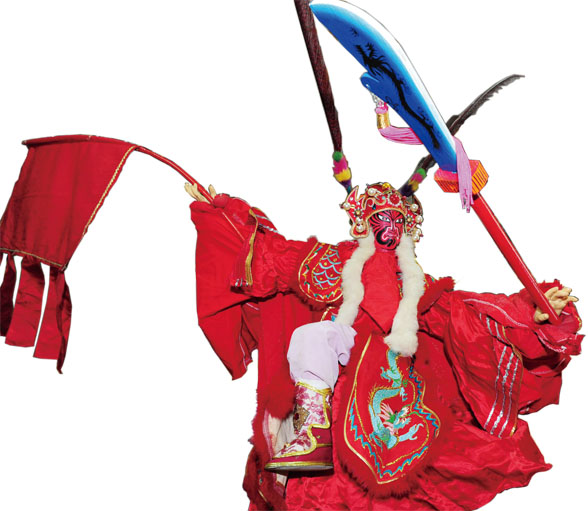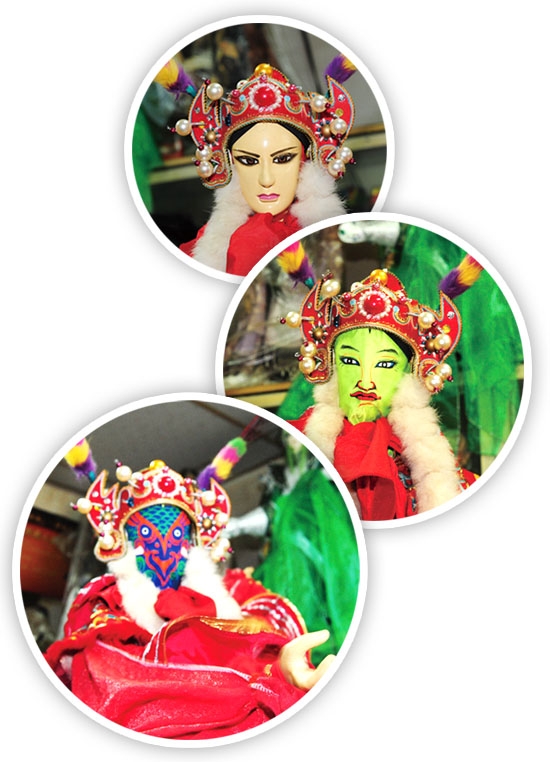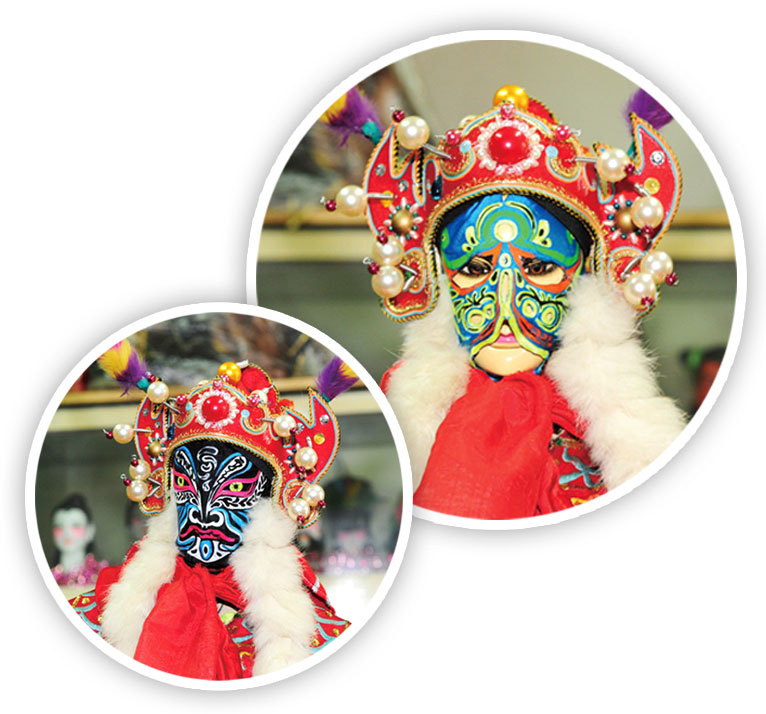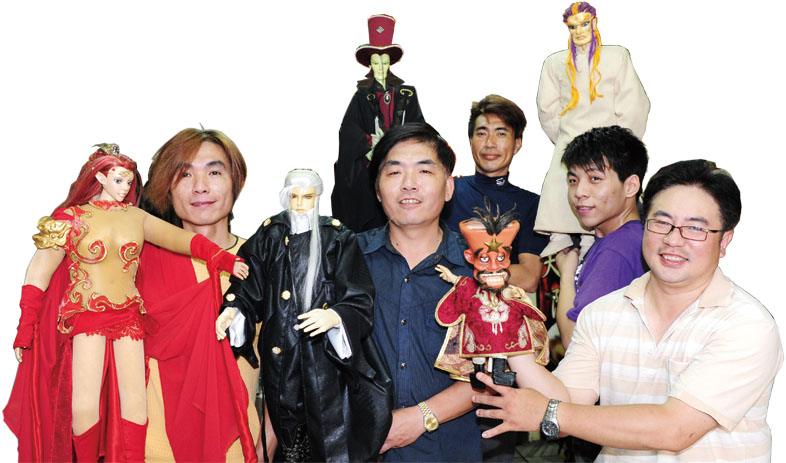A Legend in the Making - Kaohsiung New World Hand Puppet Troupe/高雄新世界掌中劇團 寫傳奇
 A Legend in the Making - Kaohsiung New World Hand Puppet Troupe
A Legend in the Making - Kaohsiung New World Hand Puppet Troupe
◎English translation: Peng Hsin-yi
◎Photos by Pao Chung-hui
Hand-puppet shows are a fundamental element in Taiwanese folk culture. Originating back in the middle of 17th century in Quanzhou, in the mainland Chinese province of Fujian, hand puppetry was brought to Taiwan by early Fujianese settlers. These performances were popular because they used to be a major form of entertainment. In religious ceremonies, puppet shows were performed to honor gods. They also served to transmit culture and history from one generation to another at a time when most people were illiterate. Today, hand-puppet shows are still often performed, but the stories have veered away from the traditional repertoire of classic novels and folk legends. The language has become more contemporary, and the stories are highly imaginative. The hero always survives impossible ordeals and lives to triumph, while the villain always gets his comeuppance. The stage comes alive with sound, light, and other special effects, so the wild make-believe is as convincing as possible. In hand-puppet performances, onstage-offstage interaction is traditional, and today's audiences are as engaged as ever, heartily cheering the hero while jeering the villain. And love for the form passes from one generation to the next.
 The Kaohsiung New World Hand Puppet Troupe was established in 1970 by the Wang family, and is currently managed by the family's second- and third-generation, Mr. Wang Tai-lang and Mr. Wang Jheng-ci, respectively. The father-and-son team work closely to realize their shared vision to modernize hand puppetry, and make it relevant rather than nostalgic. For these two, there are no boundaries when advancing the transformation of the art form. Recently, they added magic and Sichuan opera's "face changing" technique to their shows. Their efforts have been rewarded; their shows are very popular, and they perform to full houses of excited fans who are with them all the way.
The Kaohsiung New World Hand Puppet Troupe was established in 1970 by the Wang family, and is currently managed by the family's second- and third-generation, Mr. Wang Tai-lang and Mr. Wang Jheng-ci, respectively. The father-and-son team work closely to realize their shared vision to modernize hand puppetry, and make it relevant rather than nostalgic. For these two, there are no boundaries when advancing the transformation of the art form. Recently, they added magic and Sichuan opera's "face changing" technique to their shows. Their efforts have been rewarded; their shows are very popular, and they perform to full houses of excited fans who are with them all the way.
The senior Mr. Wang grew up watching his father operating puppets, and he knows everything there is to know about hand puppetry. Because he loved such shows so much, he became an apprentice at 13, and by the time he was 14, he was already performing roles requiring lines. These are the most challenging type of role, and not everyone has an aptitude for it. A show usually lasts three hours, during which the puppeteer must perform all roles, be the male or female, old or young, kind or sarcastic, somber or comic. Everything depends on the breathing techniques, voice skills, and stamina of the puppeteer.
Mr. Wang Tai-lang says that as the troupe has become more successful, he occasionally spots a few "colleagues" from other troupes in the audience. But there are things that cannot be mimicked simply by watching. As soon as Mr. Wang picks up a puppet, one can see the difference. A performance puppet is usually 90 to 100 cm (35 to 39 inches) tall; the face is extremely detailed including eyes that can blink. The hair, makeup and costumes of the puppets are styled by specialists; preparing a puppet is as expensive as dressing a human star. New World is the only puppet troupe that performs on open stages at this level of complexity.
The current hit show is based around the Sichuan opera "face changing" technique, and the lead puppet is named Master Face Change. Designed and made by New World, it requires two puppeteers when performing. Currently this role is taken by Mr. Wang Jheng-ci and his uncle, Mr. Wang Yi-lang. Each role has an opening line to announce its stage entrance, and Master Face Change's is this:
"Do not wonder if I a man or a woman, see me as the wonder known as Master Face Change."
The "face change" technique depends on speed; with a swoosh of his sleeve, Master Face Change wears a different mask and a different identity. It is a challenge for the puppeteers, but a very successful role wildly popular with audiences.
 A puppet troupe is like a big family, and everyone has his or her responsibilities. When the troupe is touring with a stage 60 Taiwanese feet in size (about 18m), it usually means 16 members and 40 to 50 puppets are on the move. There is a truck for equipment, plus a vans and sedans for accessories, people, and puppets. In addition to the actual show time, the stage takes about five hours to set up and two hours to dismantle, so an average working day usually does not end until wee hours of the morning. But their love for the art keeps the troupe members going. The thunderous applause from the audience when the curtain falls is the force that propels them to keep developing new shows.
A puppet troupe is like a big family, and everyone has his or her responsibilities. When the troupe is touring with a stage 60 Taiwanese feet in size (about 18m), it usually means 16 members and 40 to 50 puppets are on the move. There is a truck for equipment, plus a vans and sedans for accessories, people, and puppets. In addition to the actual show time, the stage takes about five hours to set up and two hours to dismantle, so an average working day usually does not end until wee hours of the morning. But their love for the art keeps the troupe members going. The thunderous applause from the audience when the curtain falls is the force that propels them to keep developing new shows.
高雄新世界掌中劇團 寫傳奇
◎文/侯雅婷
◎攝影/鮑忠暉
創立於1970年的「高雄新世界掌中劇團」,現由第二代的王泰郎和第三代的王政祺共同擔綱演出,劇團朝布袋戲現代化方向經營,不斷創新表演方式,最新推出表演融入川劇變臉和變魔術,叫好又叫座。
布袋戲是台灣庶民文化不可或缺的要角。源於十七世紀中國福建泉洲的布袋戲,在台灣發揚光大。為了迎神和謝神衍生的廟口野台戲給了布袋戲職人一片璀燦舞台,在表演者和觀眾互動之中,文化生根。台灣布袋戲在俠義的框架下,打不死的主角結合武打和天馬行空的故事情節,搭配炫目的聲光特效,舞台效果十足。台灣布袋戲以當代的語彙和造型演出,貼近觀眾的生活,賦予布袋戲嶄新風格。
王泰郎從小看著父親操作布袋戲,嫻熟布袋戲演出,興趣使然,13歲正式拜師學藝,14歲即挑大樑,擔任最具挑戰性的口白師傅一職,口白師傅這一職可不是人人都捧得起的飯碗,一場3小時的戲碼,口白師傅靠著聲音的變化演繹生、旦、淨、末、丑場上全部角色,得一氣呵成,沒有中場休息,全憑丹田功夫。
 王泰郎表示,劇團的口碑演出,吸引滿載的觀眾之外,同業也會到場觀摩。他拿起一尊90~100公分高的精緻布袋戲偶主角,木刻的臉龐維妙維肖,眼睛會眨、造型講究,戲偶從髮妝到鞋子,皆由專人打造,造價不斐,高雄新世界是唯一一團將這樣等級的戲偶搬上野台演出。
王泰郎表示,劇團的口碑演出,吸引滿載的觀眾之外,同業也會到場觀摩。他拿起一尊90~100公分高的精緻布袋戲偶主角,木刻的臉龐維妙維肖,眼睛會眨、造型講究,戲偶從髮妝到鞋子,皆由專人打造,造價不斐,高雄新世界是唯一一團將這樣等級的戲偶搬上野台演出。
高雄新世界最新的口碑演出是可換16張臉譜的川劇變臉,為劇團籌畫多年的鉅作,團員自製專門負責變臉的木偶「變臉小生」,演出時須由二人通力合作,由王政祺和叔叔王義郎擔崗演出,布袋戲要角出場時都有一段口白,觀眾得以由口白一窺劇中人的個性,王泰郎針對這尊木偶設計出一段口白:「是男是女無人知,天下第一奇『變臉小生』」,叔姪二人聯手操偶,木偶在變臉之際會用手袖略略遮住臉,一眨眼的功夫,即換上不同的面具,速度之快,讓人嘆為觀止,操偶者身手不凡,走下台貼近群眾,戲偶在觀眾眼前瞬間變臉,現場響起如雷的掌聲。
劇團像個大家庭,遇有大戲棚(60呎)演出,得出動16位團員、40~50尊戲偶 ,連同運載的交通工具一台大貨車、小貨車和轎車,聲勢浩大,搭台前置作業耗時5小時、拆舞臺2小時,一番折騰,返家時都已三更半夜了,但這群布袋戲職人的熱情不減,支撐他們不斷推出新作品的動力是台下觀眾熱情的掌聲。